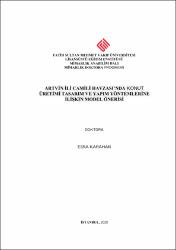Artvin İli Camili Havzası'nda Konut Üretimi Tasarım ve Yapım Yöntemlerine İlişkin Model Önerisi
Citation
KARAHAN, Esra, Artvin İli Camili Havzası'nda Konut Üretimi Tasarım ve Yapım Yöntemlerine İlişkin Model Önerisi, Fatih Sultan Mehmet Vakıf Üniversitesi Lisansüstü Eğitim Enstitüsü Mimarlık Anabilim Dalı, Yayımlanmamış Doktora Tezi, İstanbul 2020.Abstract
Camili Havzasının geleneksel mimarisi, bölgenin iklim koşulları, topografik yapısı, yerel malzeme olanakları çerçevesinde alınabilecek mimari kararların ve uygulamaların başarılı örneklerini içermekte, bölge insanının, doğa ve çevresi ile ilişkilerini yansıtmaktadır. Havzanın geleneksel mimarisi yapım sistemi, ahşap yığmadır. Bölgede bu yapım tekniği ile inşa edilen yapıların, ön yapım mantığında kurgulanmış olması, havzanın geleneksel mimarisinin dikkat çekici özellikleri arasındadır. Havzanın insan yaşamını zorlayıcı iklim koşulları ve coğrafi yapısı, iş imkanlarının kısıtlı olması, yıllar içinde bölgeden göçe neden olmuştur. Günümüzde ise; iyileşen karayolu ulaşımı, yerelde yapılan kalkınma öncelikli projeler ile ekolojik tarımın desteklenmesi, sivil toplum örgütlerinin bölgede yürüttüğü çalışmalar ile arıcılığın gelişmesi, doğa turizmin yaygınlaşması ile bölgeye ilginin artması ve turizmin getirdiği yeni iş olanakları gibi etkenler, geri göçe neden olmaktadır. Ortaya çıkan konut ihtiyacı, mevcut yapıların onarılması ya da yeniden yapılması yoluyla çözülmektedir. Özellikle betonarme karkas yapım sistemi kullanılarak inşa edilen konut yapılarında, bölgenin çok nemli iklim koşulları, erozyona yatkın toprak yapısı, uygulamacıların teknik bilgi eksikliği gibi nedenler ile; estetik ve yapısal olarak sorunlu, niteliksiz yapı üretimi ile karşılaşmaktayız. Buradan hareketle, Artvin İli Camili Havzası’ndaki yerleşimlerde, güncel konut üretiminde izlenmesi gereken tasarım ve yapım yöntemleri neler olmalıdır sorusu çalışmanın ana eksenini oluşturmuştur.
Çalışma yöntemi olarak, kapsamlı bir literatür çalışmasından sonra, ikinci aşama olarak; yereldeki konut sahipleri, uygulamacılar, sivil toplum örgütleri, yerel yönetim ve kamu kuruluşları ile karşılıklı görüşmeler yapılmış, kamu ve yerel yönetimlerin, havzanın yerel halkıyla düzenledikleri toplantılara katılınmıştır. Sonrasında yapılan alan çalışmasında, ahşap yığma yapı örnekleri, işlevlerine göre sınıflandırılarak incelenmiş, yapıların rölöveleri alınmış, fotoğraflanarak belgelenmiştir.
Camili Havzasında, evrensel standartlarda nitelikli konutların yapılabilmesi için havzanın yerel mimarisinin deneyimlerinden yararlanılmış, bölgenin üretim ve tüketim koşullarına uygun, esnek planlama olanakları sunan, ön yapıma ve kuru montaja olanak veren yapı bileşenleri ile kurgulanmış, yerel ustaların en az hatayla tamamlayabileceği yalınlıkta, sürdürülebilir; mimari tasarım ve yapım yöntemlerini belirlenmesi ve model önerisi oluşturulması doğrultusunda çalışılmıştır. The traditional architecture of the Camili Basin includes successful examples of architectural decisions and practices that can be taken within the framework of the climate conditions, topographic structure, local material possibilities of the region, and reflects the relations of the people of the region with nature and its environment. The traditional architectural construction system of the basin is wood masonry. One of the striking features of the traditional architecture of the basin is that the buildings built with this construction technique in the region were designed with pre-construction logic. The climatic conditions and geographical structure of the basin challenging human life and the limited job opportunities have caused migration from the region over the years. Today, factors such as improved transportation to the area, local projects supporting ecological agriculture, the development of beekeeping with non-governmental organizations, the increase in interest in the region with the spread of nature tourism, and new business opportunities brought by tourism cause re-migration. Locals solved the emerging need for housing by repairing or rebuilding existing buildings. In new residential buildings, especially those built using reinforced concrete carcass construction systems, are aesthetically and structurally problematic and unqualified structures. The reasons for these unqualified structures can be listed as very humid climate conditions of the region, soil structure prone to erosion, and lack of technical knowledge of the practitioners. The main research question of the study is what should be the design and construction methods to be followed in contemporary housing production in the settlements in the Camili Basin.As a research method, first, a comprehensive literature study was held by the researcher to understand area and construction techniques. On the second stage; Mutual meetings were held with local homeowners, practitioners, non-governmental organizations, local government, and public institutions. These meetings were held by civil society organizations and local government with the local people of the basin. In the field study, wooden masonry building samples were classified and examined according to their functions, the surveys of the buildings were taken, photographed, and documented.
In the Camili Basin, the experiences of the local architecture of the basin were used to construct qualified residences at universal standards. In determining the architectural design and construction methods, it has been designed with building components that are suitable for the production and consumption conditions of the region, offer flexible planning opportunities, allow pre-construction and dry assembly, and sustainable materials with a simplicity that can be completed by local craftsmen with the least error.



















